Posted by Farhan Rao.
Endangered Animals
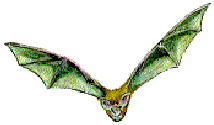 Greater Horseshoe Bat: Rhinolophus ferrumequinum
Greater Horseshoe Bat: Rhinolophus ferrumequinum
IUCN Status: least concern
Population trend: decreasing
There are eighteen species of bat in Britain and all of them are endangered - though globally they are listed as 'Least concern' as numbers in other countries remain higher - though the IUCN's Red List has marked their population as 'declining'.
The greater horseshoe bat is one of the rarest in Britain. One reason for their decline is the destruction of suitable roosting sites, such as old buildings and hollow trees. Changing land use from woodland and small fields to large scale agriculture has also had an effect. They have also suffered from the use of insecticides (poisonous chemicals sprayed on to crops to kill harmful insects) which have deprived the bats of their insect food. Due to conservation efforts its population in the UK has stabilized at about 5000.
 Siberian (Amur) Tiger
Siberian (Amur) Tiger
Panthera tigris ssp. altaica
IUCN status: Endangered
Population trend: stable
Cold, snowy Siberia, Russia, is home to the largest of all the tigers, the Siberian tiger.
Population: It is highly endangered although its numbers have increased from an all time low of 20 in the 1930s. There are now an estimated 360 Amur tigers in the wild, according to the IUCN. Hunting and loss of habitat have reduced their numbers and there is little genetic diversity in the remaining population, increasing their vulnerability There is also a tiny population remaining in China of around 20 individuals.
 Loggerhead Turtle
Loggerhead Turtle
Caretta caretta
IUCN Status: Endangered
This threatened reptile lives in the Mediterranean Sea, as well as the Black Sea and Atlantic Ocean. In the past its main dangers were hunting for its shell and meat. Now it is being disturbed by tourists populating the sandy beaches where it lays its eggs. In Turkey, hotels have been built right on its breeding sites. Out at sea, the turtles sometimes become entangled in fishing nets and drown. A possible new threat to them may be the increase in sand temperatures which determines the sex of the turtle. Warmer temperatures could result in an excess of females!
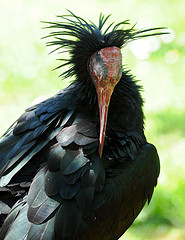 Northern Bald Ibis
Northern Bald Ibis
Geronticus eremita
IUCN Status: Critically endangered
Population trend: decreasing
Population: Morocco is home to 95% of the truly wild colonies of the ibis where populations are increasing and now number over 500 birds. Syria also has a small and declining population with only 5 mature birds (IUCN; 2006). Parts of North Africa and the Middle East are visited by these migrating birds. Turkey also have a healthy semi-wild population of reintroduced birds, numbering 91 in 2006 (IUCN). However, the use of pesticides on the marshes and grasslands where it lives is reducing the numbers.
Part of the ibis' decline is due to natural causes. It nests high above the ground and its eggs are so round that some of them roll out of the nest and break. However disturbance of nesting sites and feeding grounds is a more significant factor. The Ancient Egyptians used to depict this bird in their heiroglyphic writing, but it no longer lives in Egypt.
 White Tailed Eagle
White Tailed EagleHaliaeetus albicilla
IUCN Status: Least concern
Population trend: increasing.
Population: 5,000 - 6,000 breeding pairs in Europe. An estimated global population of 20,300 - 39,600. (IUCN).
Before humans began polluting wetland habitats with pesticides, this spectacular bird of prey was much more numerous than it is today. In the Middle East, its population is now very small. The bird travels long distances in search of fish, and eating a number of poisoned fish causes the bird to lay infertile or thin-shelled eggs which are easily broken. Modern forestry methods result in a loss of suitable nesting places. They became extinct in Britain in the early 1900s due to persecution but are now breeding in Scotland since they were reintroduced in 1975.
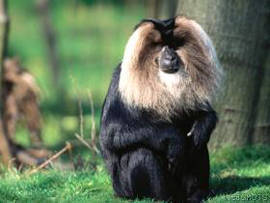 Lion-Tailed Macaque
Lion-Tailed MacaqueMacaca silenus
IUCN Status: Endangered
Population trend: decreasing.
Population: Less than 4,000.
This small monkey is only found in south-west India's tropical rainforests. Many of these forests have been cleared and replaced with tea and coffee plantations. Unlike some other animals, the lion-tailed macaque has not been able to adapt to these new habitats. Poachers have also captured baby macaques, often killing their parents in the process, for illegal export to collectors.
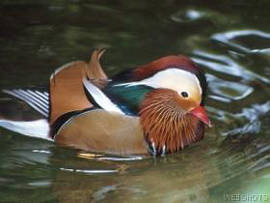 Mandarin Duck
Mandarin DuckAix galericulata
IUCN Status: Least concern
Population trend: decreasing.
The mandarin duck (the brightly coloured male is illustrated) may often be seen on ponds and lakes in Britain, but its native home is across eastern Asia, in Russia, China, Korea and Japan. It may be found on water which is near forests, but the forests are being felled and the water drained, making the duck more and more endangered.
The mandarin duck (the brightly coloured male is illustrated) may often be seen on ponds and lakes in Britain, but its native home is across eastern Asia, in Russia, China, Korea and Japan. It may be found on water which is near forests, but the forests are being felled and the water drained, making the duck more and more endangered.
 Mountain Gorilla
Mountain GorillaGorilla beringei subspecies beringei.
IUCN Status: Endangered
Population trend: unknown
Population: 300
The Virunga volcanoes region in eastern Zaire, Rwanda and Uganda is the only home of the highly endangered mountain gorilla. It depends on dense forests for survival and these are steadily being cut down to make way for crop growing and livestock grazing as well as mining. The gorilla is protected by law, but despite this, some of its so-called sanctuaries have been cleared, and hunters kill them for food and trophies, especially in the war-torn eastern Democratic Republic of Congo.
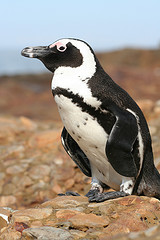 Jackass Penguin
Jackass PenguinSpheniscus demersus
IUCN Status: Endangered
Population trend: declining
Population: 52,000 mature individuals
The jackass penguin is the only penguin to be found in Africa, and it was once the country's most common sea-bird. It lives off the coast of Namibia and South Africa, and the waters here have been over-fished by humans, depriving the birds of their food supply. Oil pollution also threatens them, as does the taking of their eggs for food.
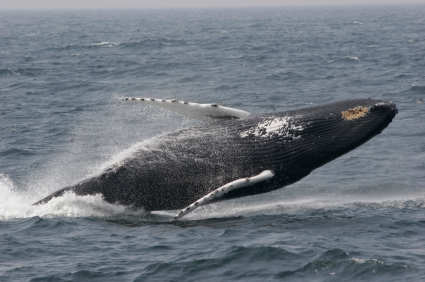 Blue Whale
Blue WhaleBalaenoptera musculus
IUCN Status: Endangered
Population trend: increasing
Population: An estimated 10,000 - 25,000 (3-11% of the 1911 population). (IUCN)
The largest animal ever to have lived on our planet, the blue whale, lives mainly in the cold waters of the Arctic and Antarctic, where it finds enough plankton to sustain it. It migrates to tropical seas to breed. The blue whale has been a protected species since 1966, but thousands were killed up until then. During the whaling season of 1930 to 1931 alone, 30,000 blue whales were killed by Antarctic whalers. It will take more than one hundred years of protection before we can be sure that it will not become extinct.
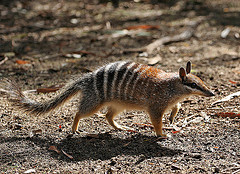 Numbat
NumbatMyrmecobius fasciatus
IUCN Status: Endangered
Population trend: declining
Population: under 1000
Sometimes called the banded anteater, the numbat was once common in the bush and forest of north-eastern and southern Australia. It is now only found in the most western part of eastern Australia. When man introduced predatory animals such as cats, dogs and foxes, these animals ate many numbats. Their numbers are still declining for the same reasons and also because their habitat is being cleared for farming and mining. Frequent fires destroy the logs which the animals use to shelter.
Sometimes called the banded anteater, the numbat was once common in the bush and forest of north-eastern and southern Australia. It is now only found in the most western part of eastern Australia. When man introduced predatory animals such as cats, dogs and foxes, these animals ate many numbats. Their numbers are still declining for the same reasons and also because their habitat is being cleared for farming and mining. Frequent fires destroy the logs which the animals use to shelter.
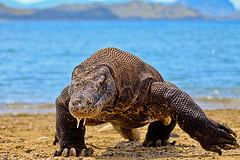 Komodo Dragon
Komodo DragonVaranus komodoensis
IUCN Status: Vulnerable
Population trend: stable (National Geographic)
Population: 3,000 - 5,000 (National Geographic)
The Komodo dragon is the largest lizard in the world and lives on a few small Indonesian islands. It is a powerful predator and can measure as much as 3 metres in length. There are about 3,000 Komodo dragons in total, but they seem to be slowly declining. They live mainly on uninhabited islands, so are in no great danger from humans. Scientists think that natural causes are to blame. There are more males than females alive, and also the natural plant life seems to be changing and the lizards are not adapting well to their new environment.
The Komodo dragon is the largest lizard in the world and lives on a few small Indonesian islands. It is a powerful predator and can measure as much as 3 metres in length. There are about 3,000 Komodo dragons in total, but they seem to be slowly declining. They live mainly on uninhabited islands, so are in no great danger from humans. Scientists think that natural causes are to blame. There are more males than females alive, and also the natural plant life seems to be changing and the lizards are not adapting well to their new environment.
 Golden Lion Tamarin
Golden Lion TamarinLeontopithecus rosalia
IUCN Status: Endangered
Population Trend: stable
Population: Over 1000.
This tiny monkey is one of the most endangered of all animals in South America. The few that are left, are restricted to the only remaining coastal rainforest, southwest of Rio de Janeiro, Brazil. Forest destruction is the main reason for the tamarin's decline, but it is also in danger of being captured alive and sold as a pet - a strictly illegal practice which still goes on in secret. At their worst, numbers declined to as low as 250 but due to a captive breeding and reintroduction programme they have increased to a healthy 1000 and live in a protected area of forest. The problem they face now is that they do not have room to expand due to the fragmention of their habitat. Fires started by cattle farmers are a continued threat.
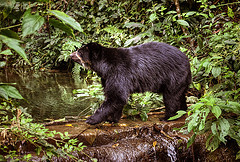 Spectacled Bear
Spectacled BearTremarctos ornatus
IUCN Status: Vulnerable
Population trend: decreasing
Population: no sufficient data; estimates of fewer than 3,000 (National Geographic)
This bear gets its name from a yellowish mask which makes it appear to be wearing a pair of spectacles! It lives in the forest-covered mountains of several South American countries. As the forests are cleared for farming, the bear's numbers fall. Even though it is protected by law, the spectacled bear is still killed by poachers for its fur, meat and fat.
This bear gets its name from a yellowish mask which makes it appear to be wearing a pair of spectacles! It lives in the forest-covered mountains of several South American countries. As the forests are cleared for farming, the bear's numbers fall. Even though it is protected by law, the spectacled bear is still killed by poachers for its fur, meat and fat.
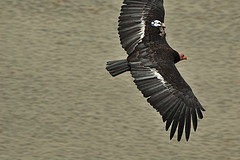 Californian Condor
Californian CondorGymnogyps californianus
IUCN Status: Critically endangered
Population trend: increasing
Population: 104 adults, but currently only 44 are producing offspring.
During the nineteenth century this large bird of prey lived in the mountains of many areas of North America. It started to decline last century when it was killed by gold diggers who collected its long black feathers. Disturbance of its habitat by tourists, pesticides and low-flying aircraft also contributed to its downfall. In 1987 the last remaining wild Californian condors were taken into captivity. They have since been reintroduced to the wild with some success, but they are still at great risk.
During the nineteenth century this large bird of prey lived in the mountains of many areas of North America. It started to decline last century when it was killed by gold diggers who collected its long black feathers. Disturbance of its habitat by tourists, pesticides and low-flying aircraft also contributed to its downfall. In 1987 the last remaining wild Californian condors were taken into captivity. They have since been reintroduced to the wild with some success, but they are still at great risk.
 Black-Footed Ferret
Black-Footed Ferret
Mustela nigripes
IUCN Status: Endangered
Population trend: increasing
Population: 500 (breeding adults).
The black-footed ferret is America's rarest mammal. It was considered extinct in the wild in 1987 but through a captive breeding programme its numbers have risen. Its decline has been due to the decline of its primary prey. This ferret hunts prairie dogs on open grassland, and as this habitat has been turned into farmland, farmers have tried to eliminate the prairie dogs, viewed as a pest, by putting poison down their burrows. The black-footed ferret has also been poisoned by accident.














